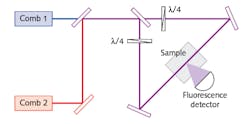Advances in Spectroscopy: Doppler-free two-photon, dual-frequency-comb spectroscopy demonstrated
To date, broadband gas-phase Fourier-transform spectroscopy has been limited to Doppler-broadened spectra with a resolution of around 30 MHz. And even though frequency combs with counterpropagating beams can be used for sub-Doppler-resolution spectroscopy, the spectra-recording capabilities are limited to atoms with only a few closely spaced transitions and are limited by the frequency comb line spacing. Typically, the resolution does not exceed 1 kHz over a frequency span of 1 GHz.
To circumvent these limitations, researchers at the Max Planck Institute for Quantum Optics (MPQ; Garching, Germany), Ludwig-Maximilians University (Munich, Germany), and the Institut des Sciences Moléculaires d’Orsay (Orsay, France) are the first to demonstrate Doppler-free (sub-Doppler resolution) recording of a species in a broadband frequency range spanning 10 THz using two-photon, dual-frequency-comb spectroscopy in a standing-wave configuration.1
Two photons and two (dual) combs
In addition to the dual-comb spectroscopy benefits of requiring only one photodetector and adjusting the sensing sensitivity and range through the properties of the two selected frequency combs, the researchers add two-photon excitation. That is, in the frequency domain, the molecular sample is excited when two summed frequencies from the combs resonate at the same transition frequency of the sample.
The detection range is limited by the span of the two frequency combs, while the resolution is limited by the frequency-comb line spacing. Instead of using small comb line spacings (around 1 MHz) to improve resolution, the research team used conventional (around 100 MHz spacing) combs, but then stepwise-scanned the comb lines to interleave the frequencies and achieve higher resolution.
In the experimental setup, a rubidium vapor sample is excited by two frequency-doubled, erbium-doped fiber laser combs with wavelengths at around 783 nm with a 100 MHz repetition frequency and adjustable difference in repetition frequencies (see figure). Each of the combs operate over a 10 THz range and one comb line is stabilized to a 193 THz continuous-wave narrowband laser for calibration.
The comb outputs are combined and then split prior to the sample, producing two circularly polarized counterpropagating standing-wave excitation pulses that meet at the sample with a total power of around 10 mW. The two-photon excitation of the sample produces a fluorescence emission that is captured by a photomultiplier.
Spectra of the rubidium sample were captured with a 1 MHz resolution for the 770.48 and 770.57 THz transitions over a range that spanned more than 10 THz. Such a broadband Doppler-free spectral result has not been possible prior to this research.
“This first proof-of-principle experiment opens up intriguing prospects for precision spectroscopy of molecules and perhaps even for fundamental tests of some of the laws of quantum mechanics. The technique could be used in any spectral regions from terahertz to the vacuum ultraviolet,” says Nathalie Picqué, research scientist at the MPQ. “However, there are still numerous experimental challenges associated with the performance of the required dual-comb systems to overcome before our technique becomes a versatile tool.”
REFERENCE
1. S. A. Meek et al., Opt. Lett., 43, 1, 162–165 (Jan. 1, 2018).
About the Author

Gail Overton
Senior Editor (2004-2020)
Gail has more than 30 years of engineering, marketing, product management, and editorial experience in the photonics and optical communications industry. Before joining the staff at Laser Focus World in 2004, she held many product management and product marketing roles in the fiber-optics industry, most notably at Hughes (El Segundo, CA), GTE Labs (Waltham, MA), Corning (Corning, NY), Photon Kinetics (Beaverton, OR), and Newport Corporation (Irvine, CA). During her marketing career, Gail published articles in WDM Solutions and Sensors magazine and traveled internationally to conduct product and sales training. Gail received her BS degree in physics, with an emphasis in optics, from San Diego State University in San Diego, CA in May 1986.
